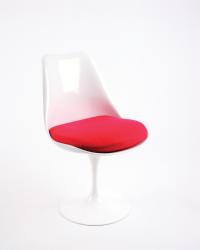Like many designers after World War II, Eero Saarinen strove to cut excess and make sleek furniture with a focus. One of his focuses — or rather obsessions — was with the bottom of chairs. He felt that no designer had ever focused on a chair bottom before and that it showed. He commented, “The undercarriage of chairs and tables in a typical interior makes an ugly, confusing, unrestful world. I wanted to clear up the slum of legs. I wanted to make the chair all one thing again.” He succeeded in making a chair with an interesting seat and base; it was the Tulip Chair, manufactured by the Knoll company in New York City in 1957.
To make the chair “all one thing again,” he tried to make the chair’s base completely out of fiberglass to match the seat shell. However, when he tested the prototype, the base was so prone to breaking that he had to think twice about his design materials. Instead of a fiberglass base, Saarinen went with painted cast aluminum to provide the user with safer support. His need to cut excess and keep designs clean played into this chair’s futuristic aesthetic. However, the chair wasn’t created alone; it was actually created out of need for chairs to match his equally futuristic table, called the Lippa Table.
With a removable leather or fabric cushion in a variety of colors, the Tulip Chair goes with more than just its counterpart, the Lippa Table. Feel free to pair this seat with any modern dining room set or add a dash of modern design to any room. It’s a classic piece with a rich history, having won an award from the Museum of Modern Art and the Design Center Stuttgart. It also won the Federal Award for Industrial Design in 1962.





